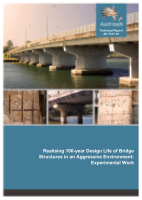Bridges

- Publication no: AP-T317-16
- ISBN: 978-1-925451-47-4
- Published: 23 November 2016
- PDF (free) Download
This report summarises the results of experiments undertaken to understand the practices required to enable a 100-year design life of bridges in an aggressive environment.
The experimental work was informed by an extensive literature review and focussed on concrete durability. The work comprised investigations into concrete deterioration mechanisms and their mitigation, including corrosion of steel reinforcement as influenced by chloride diffusion into concrete, carbonation of concrete, corrosion resistance of stainless steel, alkali-aggregate reaction and sulfate resistance of concrete.
The research indicates that the long?term deterioration of concrete ingredients can be avoided and appropriate grades of stainless steel provide very high resistance to chloride?induced corrosion under highly aggressive conditions. Careful selection of materials and appropriate levels of supervision and workmanship in the manufacture of concrete elements and on-site practices could achieve a 100-year design life for bridges in aggressive environments.
Also see the related report AP-T313-16 Realising 100-year Bridge Design Life in an Aggressive Environment: Review of the Literatur.
- Summary
- 1. Introduction
- 2. Scope of Work
- 3. Details of Experimental Work
- 3.1. General
- 3.2. Concrete Mixes
- 3.2.1. Basic Mixes
- 3.2.2. Mixes Representing Chloride-contaminated Concrete
- 3.2.3. Specimens Representing New Concrete Subjected to Chloride Ingress
- 3.3. Concrete Materials
- 3.3.1. Cementitious Materials and Water Reducer
- 3.3.2. Aggregates
- 3.4. Steel Reinforcing Bars
- 3.5. Specimens
- 4. Method of Investigation
- 4.1. Testing of Concrete Properties
- 4.2. Influence of Carbonation of Concrete on Corrosion Behaviour of Steel
- 4.3. Corrosion of Steel Reinforcement
- 5. Results: Properties of Concrete Materials
- 5.1. Concrete Mixes
- 5.2. Concrete Properties
- 5.2.1. Compressive Strength
- 5.2.2. VPV
- 5.2.3. Drying Shrinkage
- 5.3. Alkali Aggregate Reaction
- 5.4. Resistance to Sulfate Attack
- 5.4.1. Sulfate Resistance of Binder, Using Mortar Bars
- 5.4.2. Immersion of Concrete Prisms in 5% Na2SO4 Solution
- 5.4.3. Exposure to Acidic Sulfate Environment
- 5.4.4. Comments on Methods of Testing Sulfate Ressitance
- 6. Results: Corrosion-Related Properties of Concrete and Steel Bars
- 6.1. Resistance to Chloride Ion Penetration
- 6.1.1. Electrical Indication of Concrete to Resist Chloride Penetration, Tested by ASTM C1202, Non-steady State Diffusion Coefficient and the Age Effect
- 6.1.2. Chloride Diffusion Coefficient Determined by NT Build 443
- 6.1.3. Relationship between Diffusion Coefficient Tested by the Two Methods
- 6.1.4. Diffusion Coefficient Determined by Bulk Diffusion at Different Chloride Concentrations
- 6.2. Corrosion of Steel Bars in Chloride-contaminated Concrete
- 6.2.1. Uncarbonated Concrete
- 6.2.2. Chloride-contaminated Concrete Subjected to Carbonation
- 6.2.3. Normal Concrete Exposed to Corrosive Environments
- 7. Prediction of Service Life of Reinforced Concrete
- 7.1. Concrete Material Failure
- 7.2. Failure Induced by Steel Reinforcement Corrosion
- 7.2.1. De-passivation of Steel
- 7.2.2. Corrosion Rate of Steels and Critical Corrosion Depth
- 7.2.3. Estimation of Severity of Corrosion of Stainless Steel
- 8. Summary and Conclusions
- 8.1. Suggested Approaches for Achieving 100-year Design Life for Concrete Structures in Aggressive Environments
- References
- Appendix A Details of Results
- A.1 Properties of Concrete
- A.1.1 Compressive Strength
- A.1.2 VPV
- A.2 Durability Properties
- A.2.1 Results of Chloride Ion Penetration Accelerated by Electric Field
- A.2.2 Diffusion Coefficient by Immersion
- A.3 Steel Corrosion by Gecor6A/8A
- A.3.1 Concrete Without Carbonation
- A.3.2 Concrete With Carbonation
- A.3.3 Normal Concrete under Different Exposure Conditions
- A.4 Steel Corrosion by GP5000
- A.4.1 Concrete Without Carbonation
- A.4.2 Concrete under Carbonation
- A.4.3 Normal Concrete under Different Exposure Conditions
- Appendix B Reference Data
- B.1 Corrosion of Mild Steel Bars
- B.2 Corrosion Rate of Stainless Steel Bars in Concrete of Two Different Strength Grades
- B.3 Water Viscosity
